-
Engine4.6L V8
-
Power385 HP / 333 LB-FT
-
Transmission6-Speed Auto
-
DrivetrainRear-Wheel Drive
-
Curb Weight4,592 LBS
-
Seating2+2
-
Cargo16.7 CU FT
-
MPG16 City / 24 HWY
What A Difference A Year Makes
There was a point in time where if we read one more lede that started with "Hyundai sure is on a roll these days," we would have clawed our eyes out. Fact of the matter, though, is that those words were absolutely true. Hyundai has really come a long way here in the United States, especially in the past couple of years. And the only reason people have stopped writing about Hyundai's forward momentum is because, frankly, we expect nothing less now. Every new product blows the doors off of the one that came before it, and brand-new ventures like the Genesis line or funky-fresh Veloster are nothing short of impressive.
But every family has its black sheep, and unfortunately for Hyundai, that might be the largest one in its herd. You see, while Hyundai has worked hard to create a unique brand identity here in the United States by offering cars that are designed specifically with our market in mind, the Equus was simply a vehicle hauled over from Korea with a few minor Americanized tweaks. Don't get us wrong, the Equus is a plenty good car, and through its faults, we praised it in both our initial first drive and follow-up review as being a tremendous value that's pretty darn up to snuff with its competitive set. But over time, can something that's simply a good value work in the highly competitive full-size luxury set?
That in mind, we ordered a White Satin Pearl 2011 Hyundai Equus Ultimate for our long-term garage in order to see if after one year of day-to-day use, the big flagship would be able to stand tall with the rest of its Modern Hyundai kin, or simply be another budget-minded also-ran from the days of Old Hyundai. 52 weeks and 22,638 miles later, all we can say is, man, what a difference a year makes.
There was a point in time where if we read one more lede that started with "Hyundai sure is on a roll these days," we would have clawed our eyes out. Fact of the matter, though, is that those words were absolutely true. Hyundai has really come a long way here in the United States, especially in the past couple of years. And the only reason people have stopped writing about Hyundai's forward momentum is because, frankly, we expect nothing less now. Every new product blows the doors off of the one that came before it, and brand-new ventures like the Genesis line or funky-fresh Veloster are nothing short of impressive.
But every family has its black sheep, and unfortunately for Hyundai, that might be the largest one in its herd. You see, while Hyundai has worked hard to create a unique brand identity here in the United States by offering cars that are designed specifically with our market in mind, the Equus was simply a vehicle hauled over from Korea with a few minor Americanized tweaks. Don't get us wrong, the Equus is a plenty good car, and through its faults, we praised it in both our initial first drive and follow-up review as being a tremendous value that's pretty darn up to snuff with its competitive set. But over time, can something that's simply a good value work in the highly competitive full-size luxury set?
That in mind, we ordered a White Satin Pearl 2011 Hyundai Equus Ultimate for our long-term garage in order to see if after one year of day-to-day use, the big flagship would be able to stand tall with the rest of its Modern Hyundai kin, or simply be another budget-minded also-ran from the days of Old Hyundai. 52 weeks and 22,638 miles later, all we can say is, man, what a difference a year makes.
Our long-term car was a fully decked-out Equus Ultimate with an as-tested price of $65,400. The big win for the Ultimate package is the rear-seat setup, which ditches the bench of the Signature model for a pair of heated and cooled chairs (the passenger-side seat even offers a recline function with footrest as well as massaging) with a fixed center console complete with a DVD entertainment system, dual-zone rear climate control and a refrigerator, among other niceties.Everyone from young kids to full-size adults felt impeccably comfortable in the Hyundai's rear seats.
This quickly became everyone's favorite spot in the Equus, with our passengers constantly getting a kick out of the sheer luxury offered with this setup. Everyone from young kids to full-size adults felt impeccably comfortable in the Hyundai's rear seats, and throughout the entire year, this feeling never faded. If we could change anything, as Associate Editor Jeff Sabatini noted, it'd be the addition of a one-touch button to bring the rear seats back to their default position. The other fault here is that when you fully recline the passenger-side seat, there isn't nearly enough legroom for full-size bodies, even when the front passenger seat moves forward. See what we mean in the video below.
Unfortunately, the front chairs were not met with compliments. If you've scanned through any of our monthly updates about the Equus, you're familiar with the seemingly endless complaints from staffers about the overinflated lumbar bulge of the driver's seat, which was bad enough at times that Editor-In-Chief John Neff nearly stuck a fork in the seat back to pop the lumbar support's air bladder. It wasn't until January 2011 that we finally resolved this problem, with the Hyundai dealer ruling our front seat defective and replacing the seat back free of charge.
Perhaps our biggest shock during the first few months of Equus 'ownership' was the sheer amount of questions and compliments the car got from people on the street, "many mistaking it for a much more expensive brand," Neff points out. "The interesting thing is about half of those people weren't surprised to find out that it's a Hyundai." Associate Editor Chris Shunk reiterates, "I got 'Is that a Lexus?' or 'That is a huge Buick,' but not once did anyone say, 'Is that a Hyundai?'" One person even mistook it for a Maserati while parked at a rest stop along Interstate 70 in Indiana. "The Equus was one of the most inquired-about-by-strangers cars I've driven in the last year or two," writes Executive Editor Chris Paukert. "I didn't expect that." None of us did.
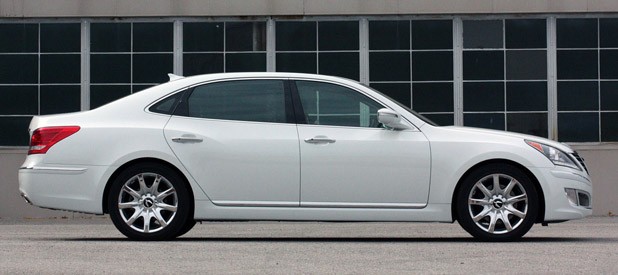
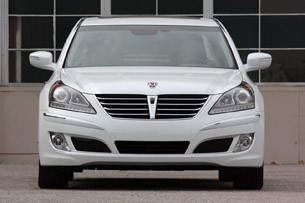
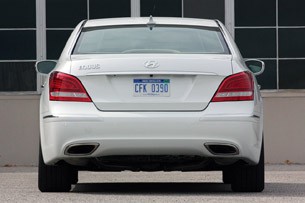
After a full year of use, the Equus' exterior showed nearly no signs of wear, though let it be known, there were two incidents in which body repairs needed to be made. During the summer months, the car fell victim to a number of scratches along the rear passenger side door (of the standard – and unreported – runaway shopping cart variety), and one of our drivers accidentally curbed the lower front lip near the driver's side fog light, severely gouging the lower fascia – enough to warrant a replacement. That ding set us back $699.25, but the aforementioned scratches were easily buffed out during one of the car's scheduled maintenance appointments.
Over the course of the year, the Equus visited four different Hyundai dealerships throughout Michigan and Ohio, with all of the appointments scheduled by the trick Apple iPad app. And while Hyundai no longer offers owners an iPad with the purchase of an Equus, it can still be downloaded free of charge. See how it works in the video below.
In total, our car was only out of service for 15 days, and each time, a loaner vehicle was delivered to our door. That's right – schedule a service appointment and the technicians will come get the car from you, free of charge.
We'll admit, our first experience with the iPad app and Equus At Your Service program was a bit clumsy. It took us a few go-rounds to actually confirm that the appointment was scheduled and the dealership failed to show up on two occasions. After vowing to never use that dealer again, we received nothing but stellar service from the other Equus-authorized dealerships, and first-time problems aside, there's no arguing the fact that Hyundai is the only automaker – luxury or otherwise – to offer this level of set-it-and-forget-it service to owners.Hyundai is the only automaker – luxury or otherwise – to offer this level of set-it-and-forget-it service to owners.
The interior, on the other hand, didn't handle daily wear and tear as well. Around late June, we noticed that the tan leather on the driver's seat was starting to become worn and discolored, and this was only highlighted more after having the driver's seat back replaced. The contrast between the brand-new cowhide and 20,000-mile-worn leather was immediately obvious, though as Sabatini points out, "part of the problem may have just been the color combo. White/tan are about the worst shades for long-term wear, and this car was abused."
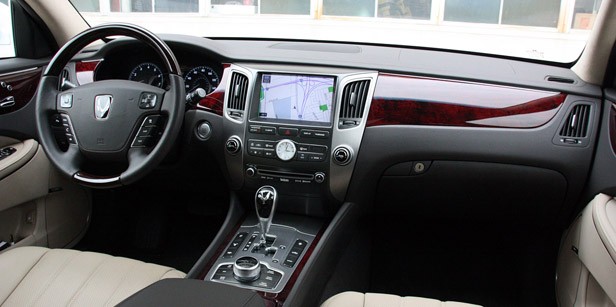
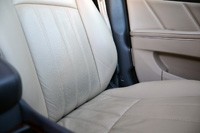
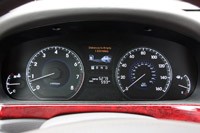
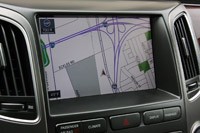
That aside, we found the Equus to be comfortable, well-appointed and spacious, even though we weren't exactly in love with the overall refinement. "There's no getting around the fact that interior bits ranging from the seat leather to the switchgear to the navigation system aren't on par with those of cars like the Audi A8 and BMW 7 Series," Paukert notes, "But in all fairness, the pricing is much easier to swallow."
During the summer months, the Equus saddled up for vacation road trip duty for a number of drivers. It "made a four-hour drive downright enjoyable in that the plethora of luxury features kept me comfortable and relaxed, the solid infotainment system kept me entertained and the adaptive cruise control made it unnecessary to even touch the gas or brake for hours at a time," praised AOL Autos Consumer Editor, Michael Zak. However, that easy-to-use infotainment system wasn't without fault. AOL Autos Editor-in-Chief, David Kiley, noted that when the DVD player was in use, you could not also use the normal radio/CD/MP3 audio functions. "With no headphones for the rear-seat kid occupants, it means if Spongebob is on the DVD player, everyone is listening to Spongebob." Yikes. (Wireless headsets are normally provided with the rear-seat DVD player, but our press car did not arrive so equipped.)"This is not a driver's car, but even the worst full-size rear-wheel-drive luxury barge is still a pretty good daily driver."
Long road trips really gave the Equus a chance to shine. "This is not a driver's car," notes Neff, "but even the worst full-size rear-wheel-drive luxury barge is still a pretty good daily driver." We found the 385-horsepower 4.6-liter V8 to have more than adequate power for all driving situations, its six-speed transmission firing off silky smooth shifts with little tendency to jump around between gears. Of course, the Equus has received a brand-new 429-hp 5.0-liter V8 and eight-speed auto for 2012, and we don't doubt that it's a welcome upgrade. Still, the 4.6-liter Tau engine was a solid powertrain and we never once experienced any sort of engine trouble.
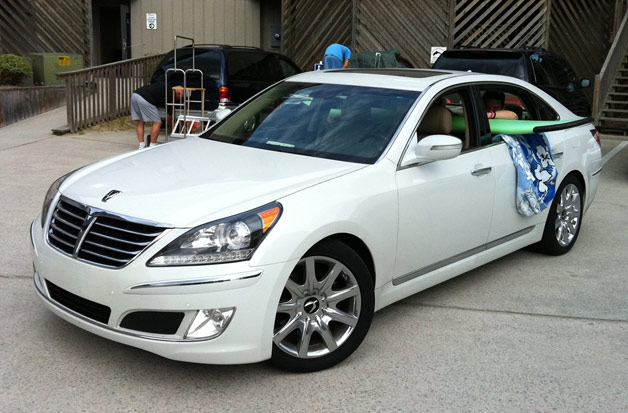
Over the course of 52 weeks, we filled up the Equus a total of 79 times, with fuel stops costing as much as $73 for a fillup (thanks to the 20-gallon fuel tank). The EPA rates the Equus at 16/24/18 miles per gallon (city/highway/combined) and our observed average during the year was a cool 21.1 mpg. On our best behavior, we managed as high as 25.8 mpg during highway runs, and even at our worst, the lowest fuel economy on record was only 16.3 mpg. We chose to run the Equus on premium fuel if only for the added oomph of power. Drive the big Hyundai on 87 octane and the engine is only rated at 378 hp and 324 lb-ft.
Now, this next part still remains a point of contention amongst the Autoblog staff. When Sabatini picked up the car just before the end of 2011, he immediately noted that the front suspension was out of whack, though other editors assured him that the car had always driven that way.
"I found the wandering nature of the front end on the Equus deeply disturbing. I have replaced the ball joints on both my BMWs more than once, and when they get bad, it feels exactly like our Equus," writes Sabatini. During his time with the car, it went in for repair, and the dealership gave him a brand-new Equus as a loaner car, which he maintains didn't feel anything like our long-termer. "Since we've verified that normal cars don't have this problem, my concern then becomes our car needing a major suspension overhaul in just 20,000 miles. With a 3 Series, that's part of the price you pay for great steering and handling, but the Equus? Not hardly. Even in the new dealer loaner I had for a weekend, I was not impressed with the steering, which felt overboosted and vague, with little on-center feel."
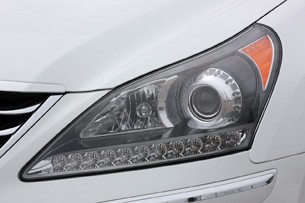
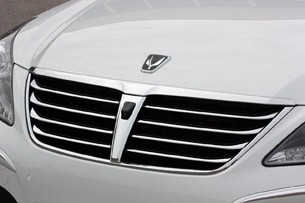
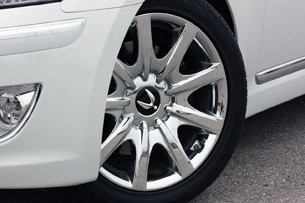
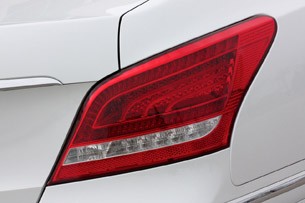
During its time at the dealer, we had the service technicians check the front suspension components, and we were told that everything was up-to-spec and a-okay. Still, other drivers aside from Sabatini noted the Equus' tendency to pull to the left, and then to the right, and then to the left again. The jury's still out on if something really was wrong with our car, but the larger point here is that the Hyundai's incredibly vague steering and wafty nature could use a tune-up even though this isn't a driver's car.
Either way, the general driving quality of the Equus seemed to fade over the course of the year. The engine remained a real sweetheart through it all, but the car just didn't feel as solid and tight as it did when it first arrived. We understand that brakes degrade and suspension components wear, but in this segment, you'd be right to expect a car that still feels brand-new after under 23,000 miles of use. The Equus... didn't.The Equus' main selling factor is value – you can't beat that $59,000 base price.
But again, the Equus' main selling factor is value – you can't beat that $59,000 base price, and some sacrifices are bound to be made. But in the full-size luxury segment, being thrifty isn't always a good thing.
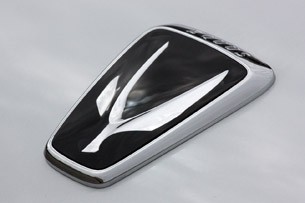
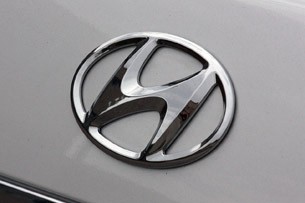
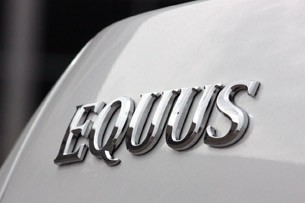
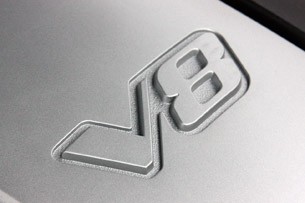
"The Equus is certainly a competent luxury vehicle," states AOL Autos Multimedia Director, Adam Morath. "It has all the bells and whistles to keep up in the ultra-luxury market at a significant discount when compared to competitors. However, it's precisely that selling proposition of affordability that presents a bit of a quandary. What are the motivating factors for buyers in this segment? Sure, nice appointments play a role, but that's really just the baseline. What it comes down to is exclusivity and brand recognition, and Equus falls well short in both those areas. In other words, when money is no object, why compromise?"
Morath wasn't the only one with these sentiments. Paukert adds, "Right now, the Equus feels like a decent car that's a very good value, when I suspect cross-shoppers of rival machines would rather have it the other way 'round.""I wouldn't be surprised if within a generation or two, the Equus noses up toward the front of the full-size luxury pack."
So while the initial synopsis for the Equus was, as we wrote, "a set of leather-covered brass knuckles flying towards the jaws of Audi, BMW and Mercedes-Benz," it appears that it might take a bit longer than expected for those luxury punches to make an impact. Summed up by editor Paukert, "Given the swift learning curve of Korea Inc., I wouldn't be surprised if within a generation or two, the Equus noses up toward the front of the full-size luxury pack."
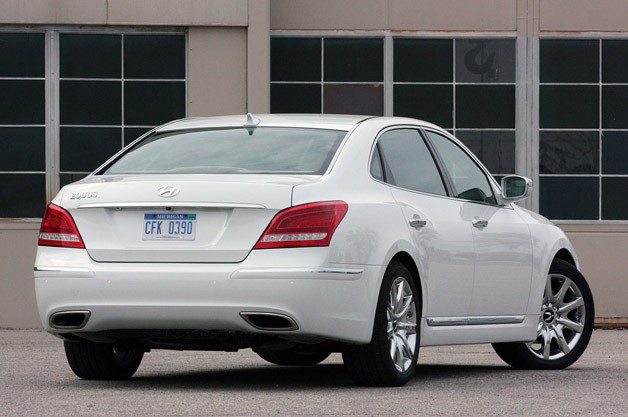
Click here to read all of our monthly updates on the 2011 Hyundai Equus Ultimate.
Long-Term Stats
Odometer at arrival: 65
Odometer at departure: 22,748
Scheduled maintenance visits: 5
Scheduled maintenance visits: 5
Non-scheduled maintenance visits: 2
Days out of service: 15
Out-of-pocket repair cost: $699.25
Number of fuel fill-ups: 79
Number of fuel fill-ups: 79
EPA estimated fuel economy: 16/24/18 mpg (city/highway/combined)
Observed average fuel economy: 21.1 mpg
Best observed fuel economy: 25.8 mpg
Worst observed fuel economy: 16.3 mpg
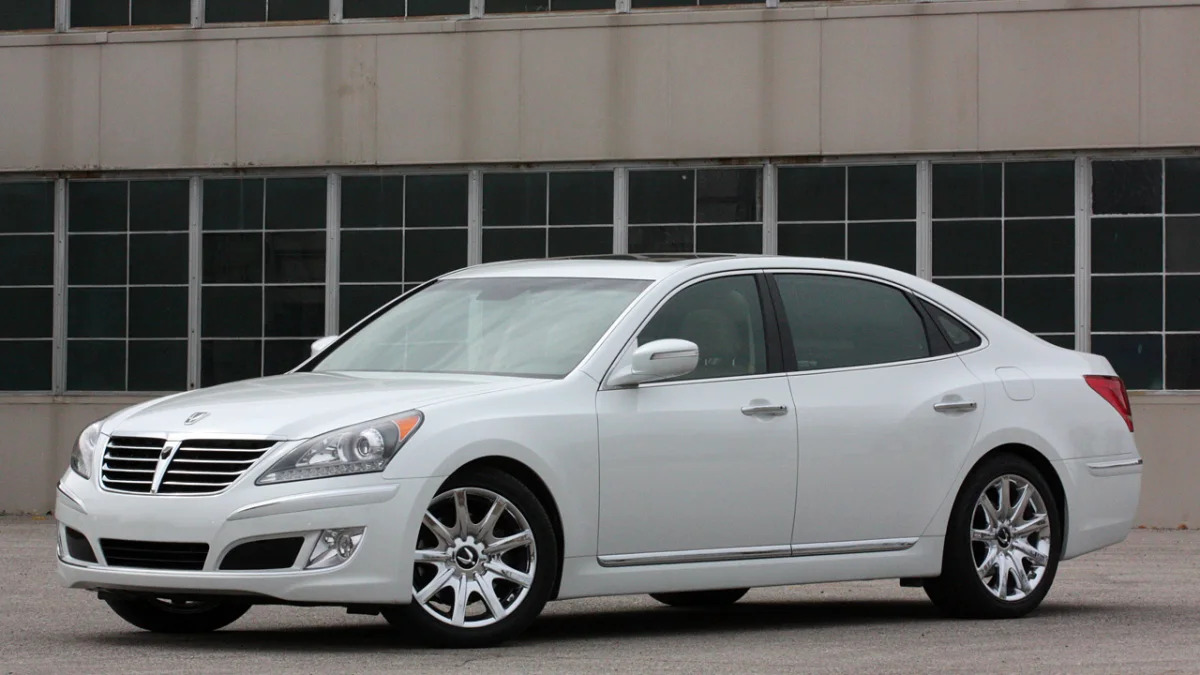









Sign in to post
Please sign in to leave a comment.
Continue